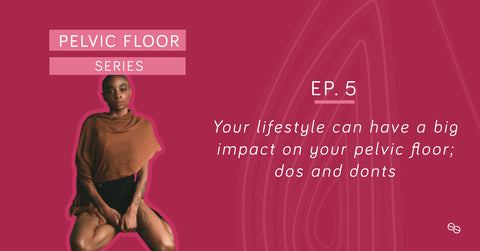Your Lifestyle Can Have a Big Impact on Your Pelvic Floor; Do's and Don'ts
There are many things we do wrong with our pelvic floor without knowing (from the way most of us probably poop to how we stand up in the morning).

Index:
Sitting on the toilet
Standing up in the morning and from anywhere we sit
Lifting weights of any kind
Take outs episode five
What's the next episode about?

As you might have learned so far in this series, our pelvic floor muscles have to be flexible and move/breath with us. Can you imagine how many movements they do every day without us realising they are actually involved in the process?
This episode is a guideline, a sort of “awareness chapter” about the 4 things you are probably doing wrong during the day and how this can affect your pelvic floor. And of course, Anna will give her advice on how to do them differently.
Sitting on the toilet
This is the number one thing almost everybody is doing wrong. You might think: how is it possible to sit on the toilet in the wrong way?? Good point. The truth is our toilets have not been created with the idea of preserving your pelvic floor health - they didn’t even know what the pelvic area was back then.
The position we assume when sitting on the toilet doesn’t allow our pelvic floor to relax and therefore “unlock” our sphincter and release. That’s why we have learned to push - which is quite wrong as well.
The truth is, the way our body has been programmed is that we shouldn’t push; if we sit correctly, relaxing is enough. Gravity will do the rest.
So, why have we all learned to sit on the toilet with parallel legs and push to release our poop? On one hand, this is purely the result of years of total absence of attention to the pelvic floor (even on the side of doctors, research and science) so we didn’t know how it really works. On the other hand, it’s just the way we have been taught - and our parents before us. And going backwards - far back in time - until when there were no sorts of toilet and we used to do it right: crouched.

If you have ever been around a toddler when she/he has to do it, usually they get crouched with their knees up. That’s where the instinct has it right.
In this position, when our knees are higher than our hips, it is just a matter of relaxing our pelvic floor and gravity will expel everything - without any pushing or muscular effort.
Why is pushing wrong? When doing it we create an extra pressure on our pelvic floor muscles, which are doing their job of keeping the “gate” closed, and it can create damages.
If you think how many times per day you sit on a toilet, you get the idea of how doing this wrong for years can impact your pelvic floor health (especially for womxn as we also pee most of the time sitting).
We can easily solve this by just placing a stool in front of the toilet and put our feet on it. The height of the stool will be different depending on how tall you are. What matters is that your knees are higher than your hips.
If you don’t have a stool that does the job, anything is ok; old books, a pile of toilet paper rolls, a box. And we should teach our kids to use the stool as well.
Another trick Anna wants to share on this quite unusual topic is a way to relax your pelvic floor muscles and avoid pushing. When sitting in the correct position, use one hand to create a sort of pipe you can blow into. Gently blow in your hand as if you have to exhale very very slowly. If you concentrate on your rectum, you’ll see it gently opens.

Standing up in the morning and from anywhere we sit
Do you know how you stand up from your bed in the morning? It took me several seconds to visualize me doing it. If you sit on the bed (sort of like the Exorcist girl) or make a crunch or similar, you are doing it wrong.
All sorts of quick squeezing movement involving our abdomen - especially after a long time resting - can damage our pelvic floor muscles creating contracted areas.
Same goes for standing up from chairs, sofas and anything else. If you do it by changing your body’s balance and getting forward rather than up, that creates the same effect on your pelvic floor.
I’ve learnt also sitting with crossed legs is not good (super guilty!). It’s funny how the position of a Lady - which has been proposed to us for centuries as the perfect, “you must adopt it”, way to sit - is actually quite wrong for our pelvic health.
We should get up from the bed by first turning on a side, then sitting on the bed helping us with one arm and finally getting up by pushing up and not forward.
Imagine you have something on your head that must not fall. If you do so, you’ll notice you immediately keep your neck straight, relax your shoulders and stand up in the right way. Be proud, be the boss in the room. “Tits up” as someone said or head-on. That’s the correct position!

Lifting weights of any kind
That’s probably the one thing we are most aware we have to pay attention to, in order to avoid hurting our back. Let’s say, in the process, we avoid hurting the pelvic floor as well. Remember - whatever you have on your head must not fall.
However, it’s not easy to remember every time we carry or take our baby, or when we have bags or a water box to lift or our job is to move things around. Definitely it is almost impossible to pay attention to those details if you are alone and have to multitask.
That’s why Anna’s advice is to first be aware of how all those repeated movements done wrong can impact on your pelvic health in the long run (mostly resulting in a hypertonic pelvic floor and the relative disfunciones we mentioned in the previous chapters) and then she suggests you add at least one self-care/pelvic-care moment in your day.
________________________________________________________________
You may also like: Urine Leaks, Prolapse and Pelvic Floor
________________________________________________________________
Like when you stretch your arms or neck in bed at night or if you practice meditation/relaxation/stretching remember to relax also your pelvic floor. Inhale and exhale several times, maybe lying down. If you do so, you’ll give your pelvic floor time to decontract and restore its ability to be flexible rather than just contracted all the time.

Take outs episode five
Our pelvic floor moves with us; we have to be aware there are certain actions/moves we do everyday (more than once) that might have a negative effect on it, which can result, in the long run, in having a hypertonic pelvic floor.
The way we sit on the toilet is wrong. We should have our knees higher than the hips and we should not push.
The correct posture - and actions we should take to get up/stand up - implies having something on our head we don’t want to fall on the floor. Standing up from the bed: turn on one side, use one arm to lift you up and get seated on the bed with legs out. Then stand up.
It’s not easy to change our habits; if you can’t, at least take some time at the end of the day to relax your pelvic floor to avoid potential damages in the long run.
What's the next episode about?
Anna and Virginia will explain step by step how a pelvic floor evaluation should work, so that if you want to do it, you know what you should expect. What consent means when being checked by any doctor or operator? Anna will also give you two exercises you can do to learn to feel and relax your pelvic floor.

